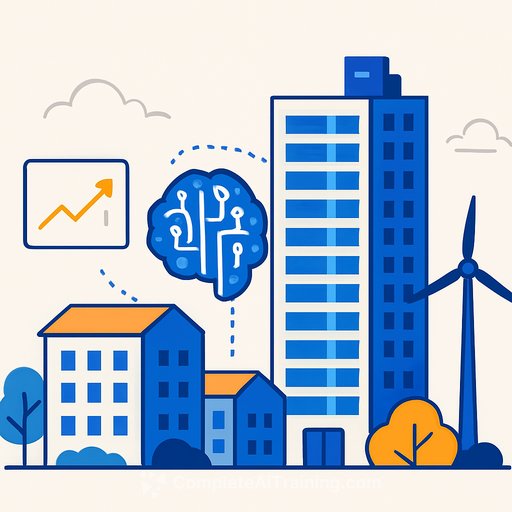GCC smart cities market set to hit USD 907.12 billion by 2032
The GCC smart cities and digital transformation market reached USD 145.54 billion in 2024 and is projected to scale to USD 907.12 billion by 2032. That's a 25.70% CAGR from 2025 to 2032, driven by AI-first national strategies, widespread 5G, and aggressive government-led build-outs.
For government, real estate, and construction leaders, this is no longer about pilots. It's about deploying connected districts at city scale-energy, mobility, healthcare, and mixed-use real estate stitched together by data.
Why this matters for you
Budgets are flowing to projects that cut operating costs, improve service delivery, and make assets measurable in real time. Between mid-2024 and early-2025 alone, GCC governments announced over USD 67 billion in new public-private digital transformation commitments.
The region has the ingredients to move fast: high 5G coverage, hyperscale data centers, and young, digital-first populations. Execution speed will separate winners from headlines.
What's driving the momentum
- 5G at scale: UAE and Saudi Arabia already exceed 97% population coverage, enabling low-latency city services and smart mobility. GSMA
- AI investment: UAE's USD 100 billion AI Vision and Saudi Arabia's USD 40 billion AI fund (launched in 2024) anchor long-term programs.
- Public spend: Saudi Arabia allocated USD 6.4 billion for digital government in the 2024-2025 cycle.
- Cloud capacity: Microsoft, Oracle, Google Cloud, and AWS expanding in Saudi Arabia, UAE, and Qatar.
- Flagship projects: NEOM and The Line, Lusail Smart City, Dubai 2040 Urban Masterplan, Masdar City, Oman Vision 2040.
Market snapshot (2024)
By offering
- Hardware (52%): ~USD 75.7B - IoT sensors, CCTV and urban surveillance, traffic systems, smart meters, 5G and energy hardware.
- Software (31%): ~USD 45.11B - cloud apps, AI/analytics, building automation, cybersecurity, digital twins.
- Services (17%): ~USD 24.73B - consulting, integration, managed cloud, operations; expected to grow the fastest through 2032.
By technology
- AI (29%): ~USD 42.2B - facial recognition, autonomous mobility, citizen service automation, energy optimization, predictive maintenance.
- 5G (23%): ~USD 33.47B - real-time services and mobility operations.
- IoT (18%): ~USD 26.2B - 65M+ active endpoints across utilities, transport, and homes.
- Cloud + Big Data (17%): ~USD 24.7B - buoyed by hyperscale expansions.
- Edge + RPA (13%): ~USD 18.9B - latency-sensitive control and process automation gaining ground.
By application
- Transportation: USD 39.8B - autonomous mobility, smart traffic, EV infrastructure, connected transit.
- Buildings & Infrastructure: USD 33.1B - smart districts, digital twins, AI-enabled BMS, modernization.
- Energy & Utilities: USD 27.4B - smart grids, AMI, AI-based load balancing, renewables integration.
- Healthcare: USD 17.8B - digital hospitals, remote diagnostics, AI imaging, national data platforms.
- Retail, education, others: USD 27.44B - expanding digital consumer ecosystems.
By end-user
- Government authorities (48%): ~USD 69.8B - central to funding and delivery.
- Commercial & Industrial (37%): ~USD 53.8B - manufacturing, real estate, logistics, fintech.
- Residential (15%): ~USD 21.8B - smart homes, automation, community IoT.
Where the contracts will cluster (2025-2032)
Hardware remains the entry point, but services and software drive long-term value. Expect multi-year O&M, managed cybersecurity, and data platform contracts to outpace bare-metal spending.
Winners will specify open, interoperable systems from day one and budget for integration, not just devices. The shift is from buying "things" to buying outcomes: uptime, response time, energy intensity, and citizen satisfaction.
Government procurement checklist
- Open standards first: Require interoperable APIs (REST/GraphQL), MQTT/OPC UA, and vendor-agnostic protocols.
- Digital twin scope: Mandate BIM-GIS integration, asset IDs, and a common data environment across contractors.
- Security baseline: Zero-trust, SOC integration, continuous pen testing, and incident SLAs measured in minutes.
- Data policy: Local data residency, tiered access, retention schedules, and audit trails by default.
- KPIs that matter: Energy per m², congestion minutes saved, water Non-Revenue Water reduction, response times, uptime SLAs.
- TCO model: 10-year cost including licenses, upgrades, connectivity, cybersecurity, and skills.
- Exit plan: Data portability and step-in rights to reduce lock-in risk.
- ESG reporting: Carbon intensity, circularity of hardware, and heat-reuse plans for data centers.
For developers and contractors
- Smart building OS: Choose platforms with app marketplaces and multi-vendor device support.
- Design for retrofit: Reserve risers, edge closets, and microgrid tie-ins to keep options open.
- MEP + IT convergence: Specify shared networks with segmentation (OT/IT), not parallel cabling forever.
- On-site compute: Edge nodes for BMS, video analytics, and mobility control where latency matters.
- EV and storage ready: Plan capacity, load management, and dynamic tariffs upfront.
- Handover clean: Digital as-builts, asset registry, firmware baselines, and a 90-day stabilization period.
12-month action plan for city authorities
- Pick two anchor use cases with visible outcomes: smart intersections in a key corridor and district-level energy optimization.
- Stand up a common data platform with identity, logging, and API governance before scaling devices.
- Issue outcome-based RFPs with clear metrics and phased acceptance tied to KPIs.
- Run a cybersecurity tabletop exercise covering OT incidents across traffic, water, and power.
- Launch a vendor-neutral integration layer to reduce one-off interfaces.
- Train internal teams on AI, data, and IoT operations; consider curated upskilling paths for roles. Courses by job
- Secure PPP financing for OPEX-heavy services and performance-linked contracts.
- Publish quarterly dashboards on energy, mobility, and service uptime to keep momentum and trust.
Sectors to watch (2025-2026)
- Autonomous shuttles and AI-based traffic optimization in dense corridors.
- Smart grid upgrades: AMI rollouts, distributed energy, and AI load balancing.
- Digital hospitals and AI imaging at national scale.
- Connected logistics in industrial zones and ports.
- Green hydrogen-ready districts and heat recovery from data centers.
- Citywide video analytics modernization with privacy safeguards.
Risks to manage early
- Skills gap in OT cybersecurity, data engineering, and AI operations.
- Interoperability debt from proprietary stacks and point solutions.
- Regulatory clarity for data sharing, AI use, and private 5G.
- Rising OPEX for software and connectivity if contracts lack price controls.
- Change management: service redesign must match the tech rollout.
Flagship programs shaping regional benchmarks
- NEOM and The Line (Saudi Arabia)
- Lusail Smart City (Qatar)
- Dubai 2040 Urban Masterplan (UAE)
- Masdar City (UAE)
- Oman Vision 2040 (Oman)
The takeaway is simple: the GCC is moving from pilots to platforms. Lock in open standards, measure outcomes, and fund integration and operations as seriously as concrete and steel. The budget is there-the execution playbook decides who benefits.
Your membership also unlocks:










